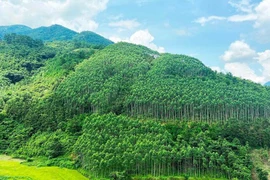The payment made to Vietnam, making it the first country in theEast Asia Pacific region to receive a results-based payment from the WorldBank’s Forest Carbon Partnership Facility (FCPF), was for reducing 10.3 milliontonnes of carbon emissions in the period spanning February 1, 2018 and December31, 2019.
This makes for the biggest single payment to date made by the FCPFfor verified and high integrity carbon credits. The benefits of this paymentare expected to reach 70,055 forest owners and 1,356 neighbouring communities,allocated according to a robust benefit-sharing plan developed through aconsultative, participatory, and transparent process.
“The success of this REDD programme brings Vietnam closer todelivering on our ambitious Nationally Determined Contributions under the ParisAgreement, while protecting areas of vital importance to biodiversityconservation,” Vietnamese Minister of Agriculture and Rural Development Le MinhHoan said.
The country is already generating emission reductions in excess ofthe volume contracted with the FCPF, and can sell the credits to third partybuyers through bilateral agreements or carbon markets.
Vietnam can also use the excess credits to fulfil its NationallyDetermined Contributions or retire them, which is a net climate benefit.
“This landmark payment marks another step for Vietnam towardsjoining the global carbon credit market and opens a new opportunity to financethe country’s ambitious climate commitments and targets,” World Bank CountryDirector for Vietnam Carolyn Turk said.
The emission reduction programme implemented between 2018 and 2019has yielded remarkable results, with a total of 16.2 million tonnes verifiedemission reductions achieved, surpassing the initial target of 10.3 million tonnesoutlined in the Emission Reduction Payment Agreement by 5.9 million tonnes. Inresponse to this success, the World Bank has issued a call option notice toacquire an additional 1 million tonne emission reductions beyond the agreedcontract volume.
Vietnam’s emission reduction programme protects most of thecountry’s tropical forests, covering 3.1 million of the 5.1 million hectares ofland in the programme area.
These forests hold immense ecological significance, forming thebackbone of five internationally recognised conservation corridors.
The area is also home to 12 per cent of Vietnam’s population,including 13 ethnic minority groups and many forest-dependent communities.
Almost one-third of people in the region live below the nationalpoverty line.
Through a multifaceted approach involving enhanced forestmanagement practices, strategic investments in the forestry sector, and therefinement of agricultural policies, the programme is actively expanding boththe coverage and quality of forested areas in collaboration with localcommunities.
The Forest Carbon Partnership Facility (FCPF) is a globalpartnership of governments, businesses, civil society, and Indigenous Peoples' organisationsfocused on reducing emissions from deforestation and forest degradation, forestcarbon stock conservation, the sustainable management of forests, and theenhancement of forest carbon stocks in developing countries, activitiescommonly referred to as REDD .
Launched in 2008, the FCPF has worked with 47 developing countriesacross Africa, Asia, and Latin America and the Caribbean, along with 17 donorsthat have made contributions and commitments totalling 1.3 billion USD./.





























